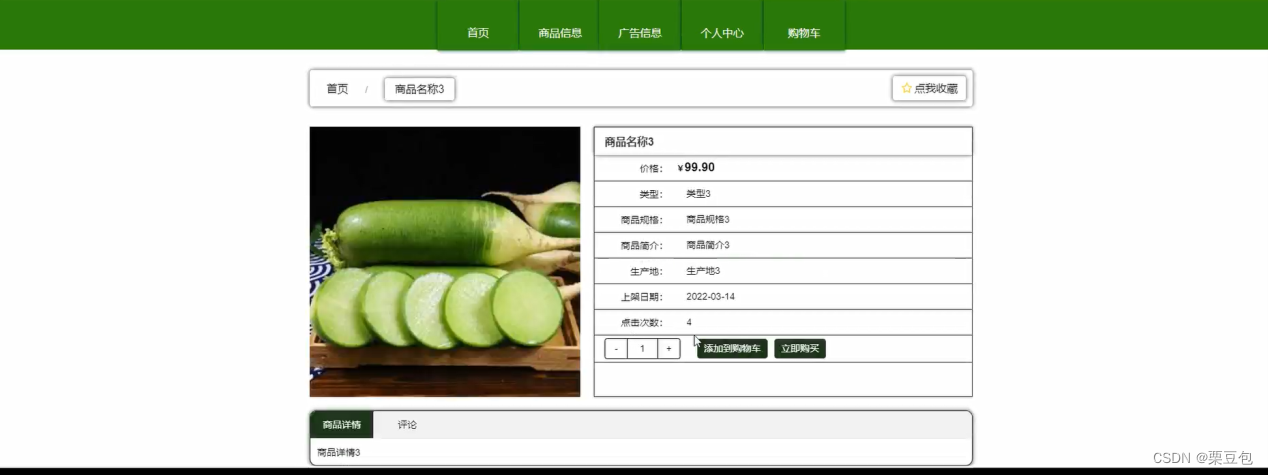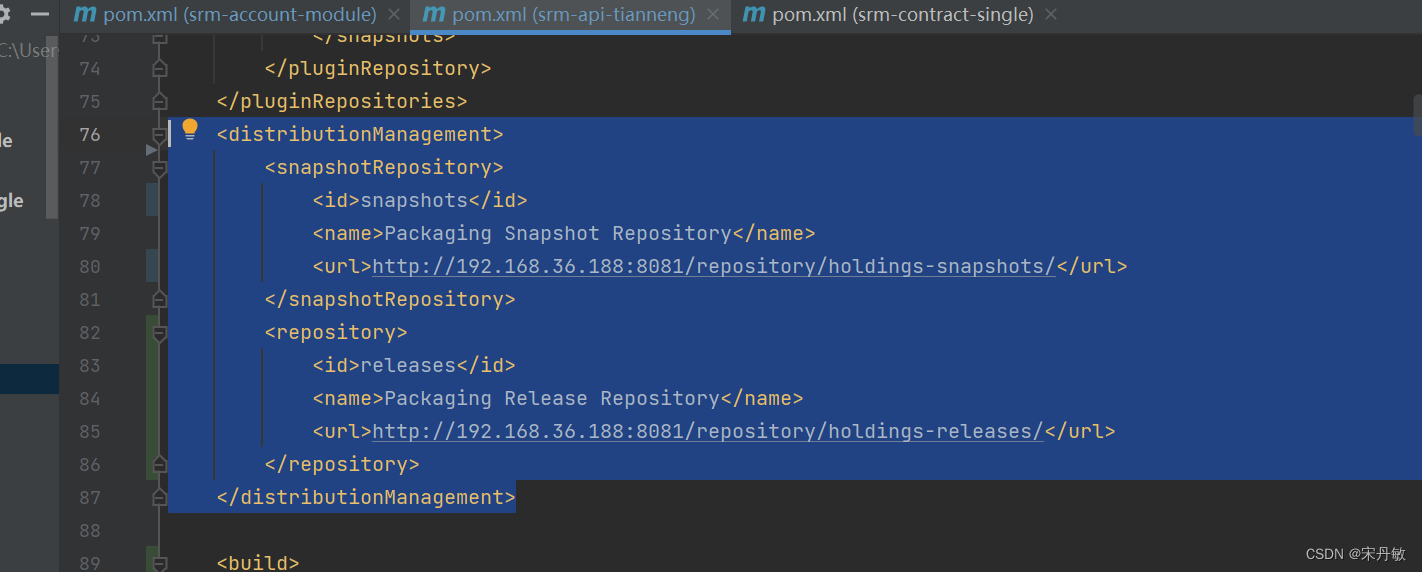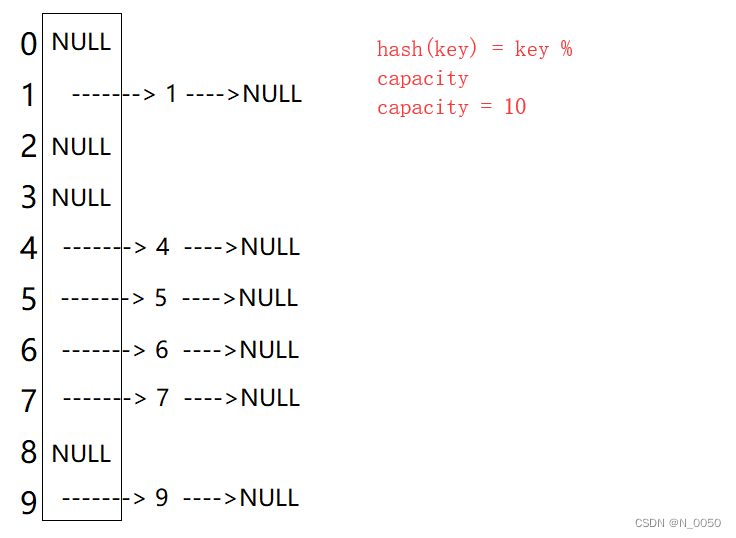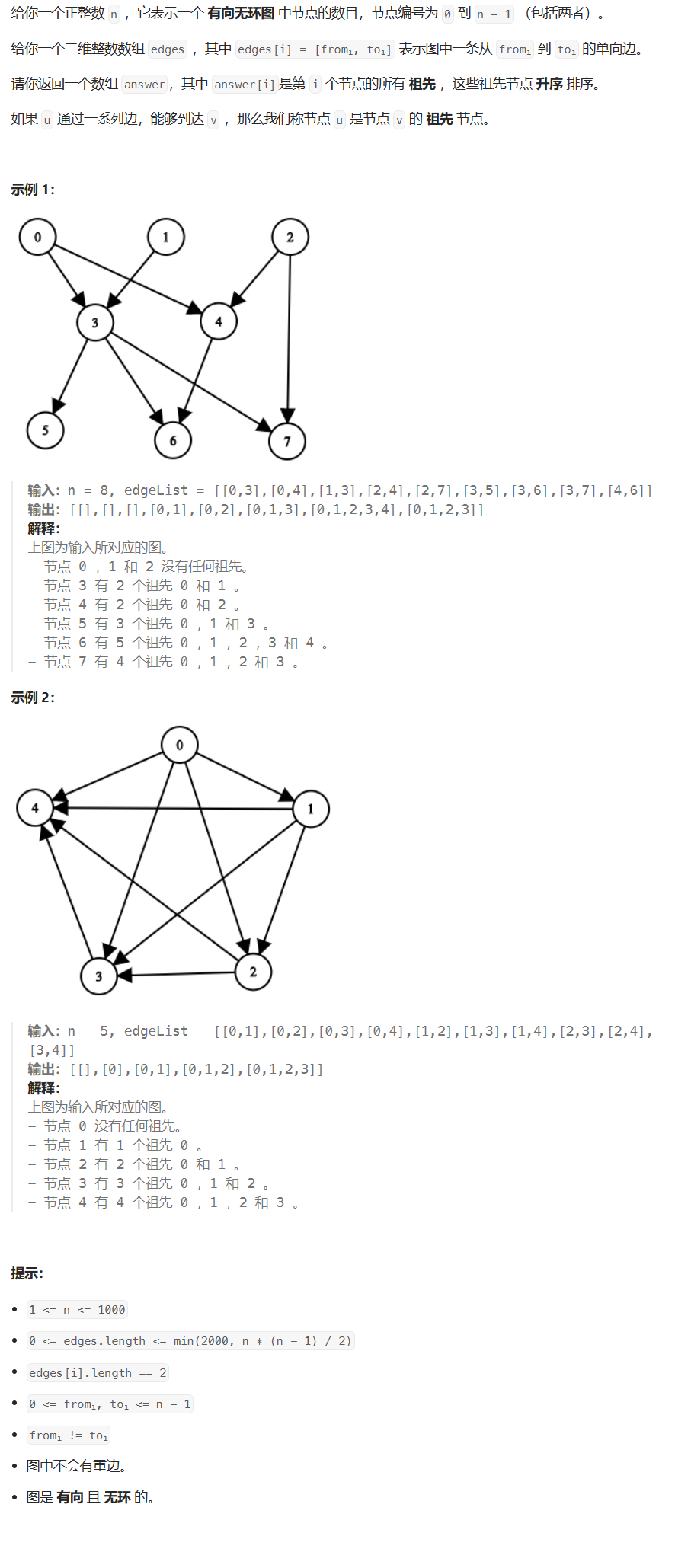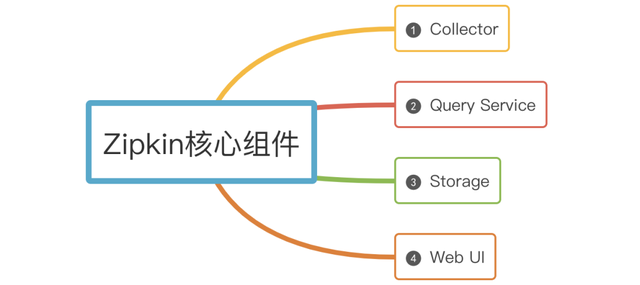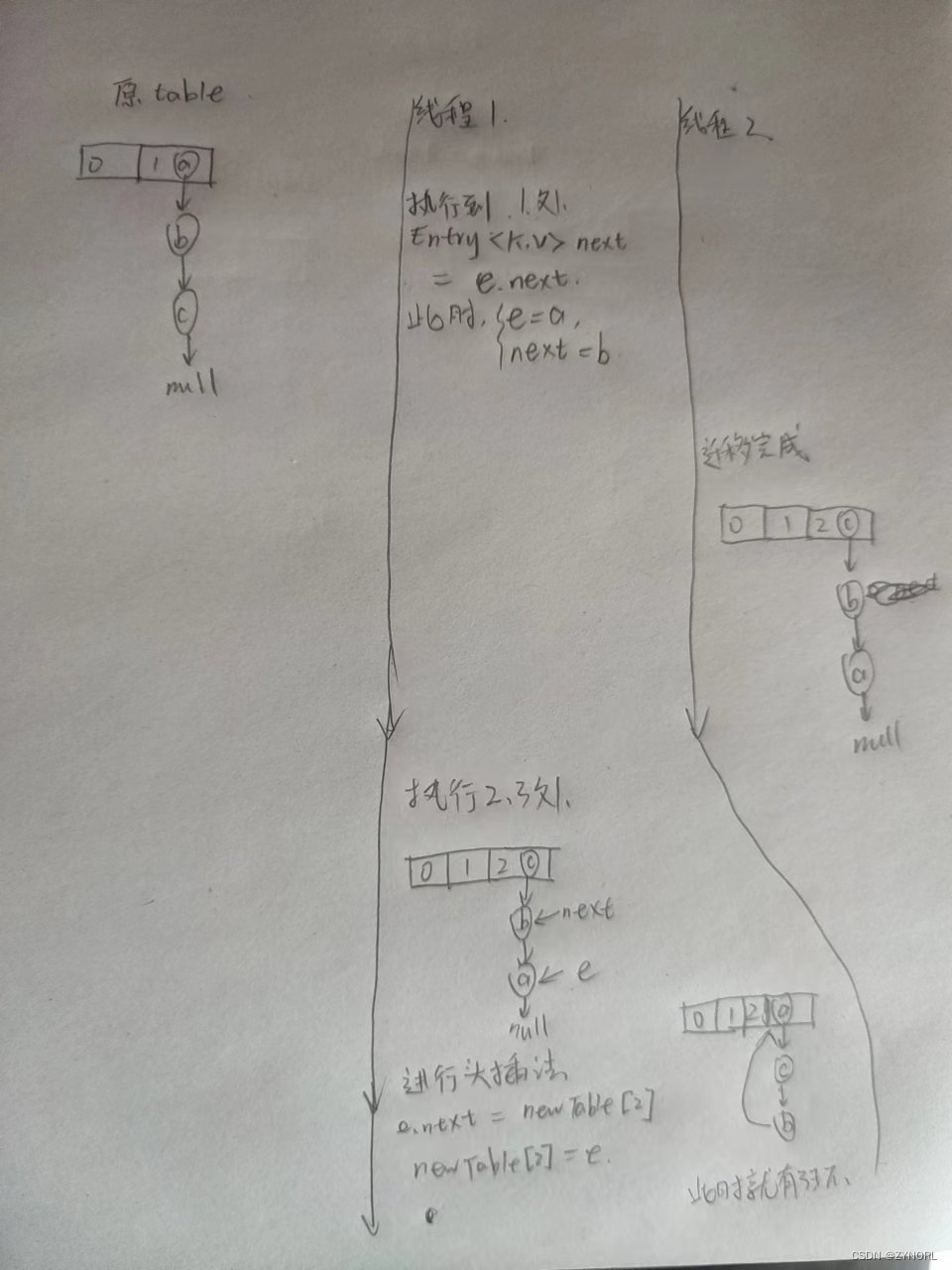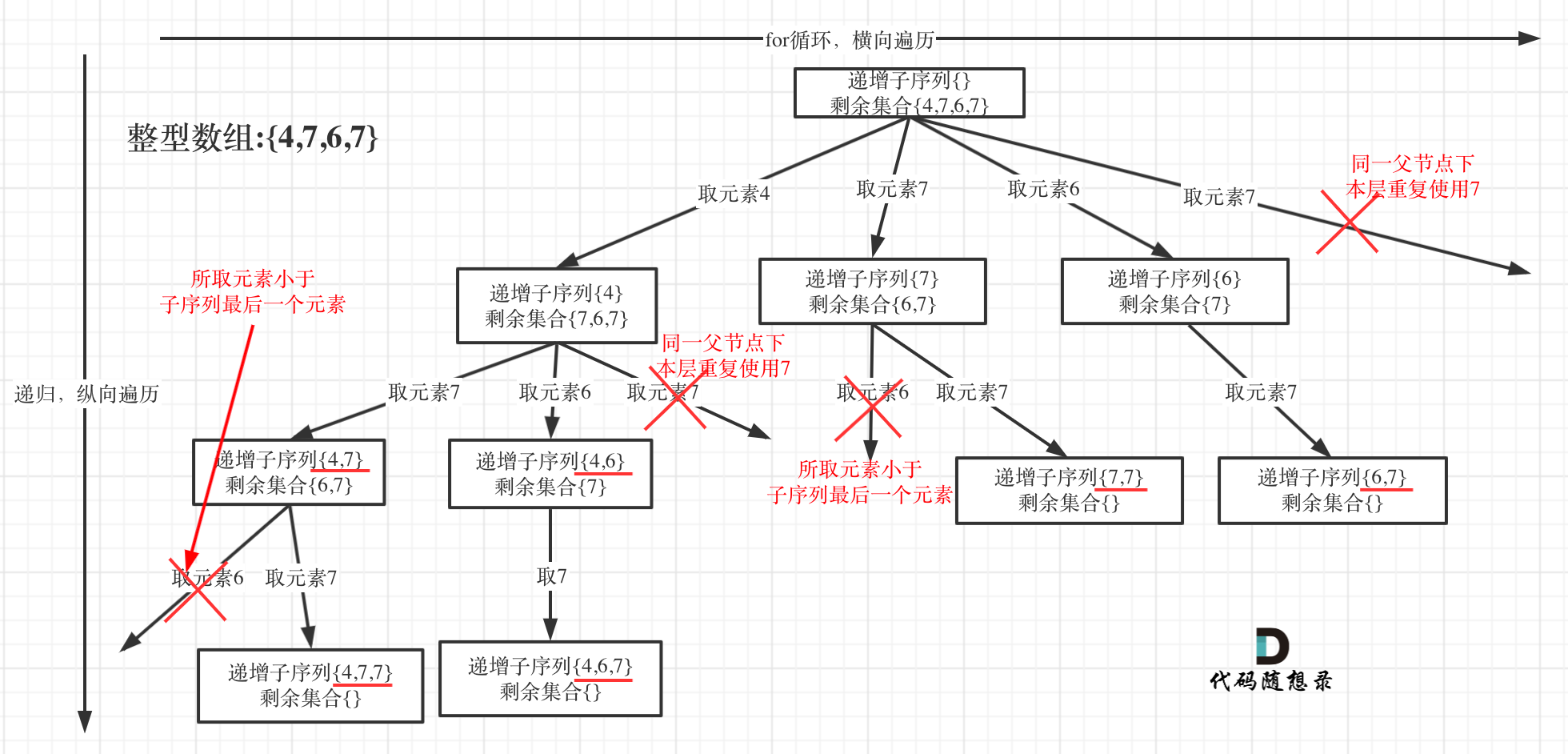目录
线程池
自定义线程池
步骤1:自定义拒绝策略接口
步骤2:自定义任务队列
步骤3:自定义线程池
步 骤 4:测 试
ThreadPoolExecutor
线程池状态
构造方法
工作方式
newFixedThreadPool
newCachedThreadPool
newSingleThreadExecutor
提交任务
1.执行任务
2.提交任务task,用返回值Future获得任务执行结果
3.提交tasks中所有的任务
4.提交 tasks 中所有任务,带超时时间
5.提交 tasks 中所有任务,哪个任务先成功执行完毕,返回此任务执行结果,其它任务取消
6.提交 tasks 中所有任务,哪个任务先成功执行完毕,返回此任务执行结果,其它任务取消,带超时时间
关闭线程池
shutdown
shutdownNow
任务调度线程池
Timer
ScheduledExecutorService
Tomcat 线程池
Fork/Join
概念
使用
线程池
自定义线程池
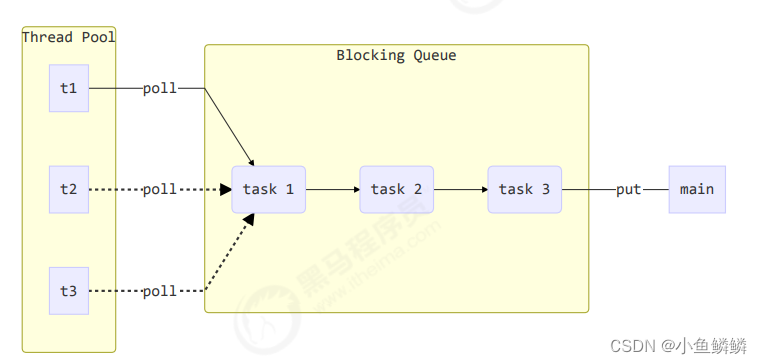
步骤1:自定义拒绝策略接口
@FunctionalInterface // 拒绝策略
interface RejectPolicy<T> {
void reject(BlockingQueue<T> queue, T task);
}步骤2:自定义任务队列
class BlockingQueue<T>{
//1.任务队列
private Deque<T> queue = new ArrayDeque<>();
//2.锁
private ReentrantLock lock = new ReentrantLock();
//生产者条件变量
private Condition fullWaitSet = lock.newCondition();
//4.消费者条件变量
private Condition emptyWaitSet = lock.newCondition();
//5.容量
private int capcity;
public BlockingQueue(int capcity){
this.capcity = capcity;
}
//超时的阻塞添加
public T poll(long timeout, TimeUnit unit){
lock.lock();
try{
//将时间统一转化为纳秒
long nanos = unit.toNanos(timeout);
while(queue.isEmpty()){
try {
if(nanos<=0){
return null;
}
//awaitNanos()方法,返回的时间是一个剩余时间,把返回的时间重新赋值给它,防止虚假唤醒,从头再等
nanos = emptyWaitSet.awaitNanos(nanos);
} catch (InterruptedException e) {
throw new RuntimeException(e);
}
}
T t = queue.removeFirst();
fullWaitSet.signal();
return t;
}finally {
lock.unlock();
}
}
//阻塞获取
public T take(){
//获取任务的时候需要保证线程安全,需要加一把锁
lock.lock();
try{
while(queue.isEmpty()){
try {
emptyWaitSet.await();
} catch (InterruptedException e) {
throw new RuntimeException(e);
}
}
T t = queue.removeFirst();
fullWaitSet.signal();
return t;
}finally {
lock.unlock();
}
}
//阻塞添加
public void put (T element){
lock.lock();
try{
while(queue.size()==capcity){
try {
fullWaitSet.await();
} catch (InterruptedException e) {
throw new RuntimeException(e);
}
}
queue.addLast(element);
emptyWaitSet.signal();
}finally {
lock.unlock();
}
}
//获取当前队列的大小
public int size(){
lock.lock();
try {
return queue.size();
}finally {
lock.unlock();
}
}
}步骤3:自定义线程池
class ThreadPool{
//阻塞队列
private BlockingQueue<Runnable> taskQueue;
//线程集合
private HashSet<Worker> workers = new HashSet<>();
//核心线程数
private int coreSize;
//获取任务的超时时间
private long timeout;
//时间单位
private TimeUnit timeUnit;
//执行任务
public void excute(Runnable task){
//当任务数没有超过coreSize时,直接交给worker执行
//当任务数超过coreSize时候,加入任务队列暂存
synchronized (workers){
if(workers.size()<coreSize){
Worker worker = new Worker(task);
log.debug("新增 worker{},任务对象{}",worker,task);
workers.add(worker);
worker.start();
}else {
log.debug("加入任务队列{}",task);
taskQueue.put(task);
}
}
}
//构造方法
public ThreadPool(int coreSize, long timeout, TimeUnit timeUnit,int queueCapcity) {
this.coreSize = coreSize;
this.timeout = timeout;
this.timeUnit = timeUnit;
this.taskQueue = new BlockingQueue<>(queueCapcity);
}
class Worker extends Thread{
private Runnable task;
public Worker(Runnable task){
this.task=task;
}
@Override
public void run(){
//执行任务
//当task不为空,执行任务
//当task执行完毕,再接着从任务队列获取任务并执行
// while (task !=null ||(task = taskQueue.take()) !=null){
while (task !=null ||(task = taskQueue.poll(timeout,timeUnit)) !=null){
try {
log.debug("正在执行...{}",task);
task.run();
}catch (Exception e){
e.printStackTrace();
}finally {
task = null;
}
}
synchronized (workers){
log.debug("worker 被移除{}",this);
workers.remove(this);
}
}
}
}步 骤 4:测 试
public class Test {
public static void main(String[] args) {
ThreadPool threadPool = new ThreadPool(2, 1000, TimeUnit.MILLISECONDS, 10);
for (int i = 0; i < 5; i++) {
int j =i;
threadPool.excute(()->{
log.debug("{}",j);
});
}
}
}以上是一个基本的不借助不借助jdk提供线程池框架的简单例子,可以自行多练习几遍,有助于理解jdk提供线程框架的底层。
ThreadPoolExecutor

线程池状态
ThreadPoolExecutor使用int的高3位来表示线程池状态,低29位表示线程数量
| 状态名 | 高3位 | 接收新任务 | 处理阻塞队列任务 | 说明 |
| RUNNING | 111 | Y | Y | |
| SHUTDOWN | 000 | N | Y | 不会接收新任务,但是会处理阻塞队列剩余任务 |
| STOP | 001 | N | N | 会中断正在执行的任务,并抛弃阻塞队列任务 |
| TIDYING | 010 | - | - | 任务执行完毕,活动线程为0即将进入终结 |
| TERMINATED | 011 | - | - | 终结状态 |
从数字上比较,TERMINATED > TIDYING > STOP > SHUTDOWN > RUNNING
这些信息存储在一个原子变量ctl中,目的是将线程状态与线程个数合二为一,这样就可以用一次cas原子操作进行赋值
// c 为旧值, ctlOf 返回结果为新值
ctl.compareAndSet(c, ctlOf(targetState, workerCountOf(c))));
// rs 为高 3 位代表线程池状态, wc 为低 29 位代表线程个数,ctl 是合并它们
private static int ctlOf(int rs, int wc) { return rs | wc; }
构造方法
public ThreadPoolExecutor(
int corePoolSize,
int maximumPoolSize,
long keepAliveTime,
TimeUnit unit,
BlockingQueue<Runnable> workQueue,
ThreadFactory threadFactory,
RejectedExecutionHandler handler
)- corePoolSize核心线程数目(最多保留的线程数)
- maximumPoolSize最大线程数目
- keepAliveTime生存时间-针对救急线程
- unit 时间单位-针对救急线程
- workQueue阻塞队列
- threadFactory线程工厂-可以为线程创建的时候起名字
- handler拒绝策略
工作方式

1.线程池中刚开始没有线程,当一个任务提交给线程池后,线程池会创建一个新线程来执行任务
2.当线程数达到corePoolSize的时候,并没有线程空闲,再来新任务的时候会加入任务队列workQueue队列排队,直到有空闲的线程
3.如果队列选择了有界队列,那么任务超过了队列大小时,会创建maximumPoolSize-corePoolSize的数量的线程来救急。
4.如果线程达到了maximumPoolSize的时候,仍有新任务这时候会执行拒绝策略。拒绝策略jdk提供了4种实现,其他著名框架也提供了实现

- AbortPolicy 让调用者抛出 RejectedExecutionException 异常,这是默认策略
- CallerRunsPolicy 让调用者运行任务
- DiscardPolicy 放弃本次任务
- DiscardOldestPolicy 放弃队列中最早的任务,本任务取而代之
- Dubbo 的实现,在抛出 RejectedExecutionException 异常之前会记录日志,并 dump 线程栈信息,方 便定位问题
- Netty 的实现,是创建一个新线程来执行任务
- ActiveMQ 的实现,带超时等待(60s)尝试放入队列,类似我们之前自定义的拒绝策略
- PinPoint 的实现,它使用了一个拒绝策略链,会逐一尝试策略链中每种拒绝策略
5.当高峰过去后,超过corePoolSize的救急线程如果一段时间没有任务做,需要结束节省资源,这个时间由keepAliveTime和unit控制
根据这个构造方法,JDK Executors 类中提供了众多工厂方法来创建各种用途的线程池
newFixedThreadPool
public static ExecutorService newFixedThreadPool(int nThreads) {
return new ThreadPoolExecutor(nThreads, nThreads,
0L, TimeUnit.MILLISECONDS,
new LinkedBlockingQueue<Runnable>());
}特点
- 核心线程数==最大线程数(没有救急线程),因此也无需超时时间
- 阻塞队列是无界的,可以放任意数据的任务
- 适用于任务量已知,相对耗时的任务
newCachedThreadPool
public static ExecutorService newCachedThreadPool() {
return new ThreadPoolExecutor( 0, Integer.MAX_VALUE,
60L, TimeUnit.SECONDS,
new SynchronousQueue<Runnable>());
}特点
- 核心线程数是0,最大线程数是Integer.MAX_VALUE,救急线程的生存时间为60s,意味着全部都是救急线程(60s后可以回收),救急线程可以无限创建
- 队列采用了SynchronousQueue实现特点是,它没有容量,没有线程来取是放不进去的(一手交钱,一手交货)
- 整个线程池表现为线程数会根据任务量不断增长,没有上限,当任务执行完毕,空闲 1分钟后释放线 程。 适合任务数比较密集,但每个任务执行时间较短的情况
示例
public class Test2 {
public static void main(String[] args) {
SynchronousQueue<Integer> integers = new SynchronousQueue<>();
new Thread(()->{
try {
log.debug("putting{}",1);
integers.put(1);
log.debug("putted{}",1);
log.debug("putting{}",2);
integers.put(2);
log.debug("putted{}",2);
} catch (InterruptedException e) {
throw new RuntimeException(e);
}
}).start();
}
}
07:37:56.496 [Thread-0] DEBUG com.example.com.yunlong.test3.Test2 - putting1从上面示例结果可以看出来,integers队列,把1放进去之后,如果没有来取的,会直接阻塞到放入元素行,不再执行下去。
newSingleThreadExecutor
public static ExecutorService newSingleThreadExecutor() {
return new FinalizableDelegatedExecutorService
(new ThreadPoolExecutor(1, 1,
0L, TimeUnit.MILLISECONDS,
new LinkedBlockingQueue<Runnable>()));
}使用场景
希望多个任务排队执行。线程数固定为1,任务数多余1时,会放入无界队列排队。任务执行完毕,这唯一的线程也不会被释放
区别
自己创建一个单线程串行执行任务,如果任务执行失败而终止那么没有任何补救措施,而线程池还会新建一个线程,保证池的正常工作
Executors.newSingleThreadExecutor()线程个数始终为1,不能修改
- FinalizableDelegatedExecutorService 应用的是装饰器模式,只对外暴露了 ExecutorService 接口,因 此不能调用 ThreadPoolExecutor 中特有的方法
Executors.newFixedThreadPool(1) 初始时为1,以后还可以修改
- 对外暴露的是 ThreadPoolExecutor 对象,可以强转后调用 setCorePoolSize 等方法进行修改
提交任务
1.执行任务
void execute(Runnable command);2.提交任务task,用返回值Future获得任务执行结果
<T> Future<T> submit(Callable<T> task);示例
public class Test4 {
public static void main(String[] args) throws ExecutionException, InterruptedException {
ExecutorService executorService = Executors.newFixedThreadPool(2);
Future<String> f = executorService.submit(() -> {
log.debug("running");
Thread.sleep(1000);
return "1";
});
//用Future对象,调用get()方法拿到结果,如果拿不到结果就在这阻塞住
log.debug("{}",f.get());
}
}总结:Runnable接口中的唯一抽象方法run()方法没有返回值,Callable接口中的唯一抽象方法call()方法有返回值。
@FunctionalInterface
public interface Runnable {
// 这个run()方法返回值为void,没有受检异常的异常声明,出现异常只能内部捕获
public abstract void run();
}
@FunctionalInterface
public interface Callable<V> {
// 这个call()方法有返回值,且声明了受检异常,可以直接抛出Exception异常
V call() throws Exception;
}3.提交tasks中所有的任务
<T> List<Future<T>> invokeAll(Collection<? extends Callable<T>> tasks)
throws InterruptedException;4.提交 tasks 中所有任务,带超时时间
<T> List<Future<T>> invokeAll(Collection<? extends Callable<T>> tasks,
long timeout, TimeUnit unit)
throws InterruptedException;5.提交 tasks 中所有任务,哪个任务先成功执行完毕,返回此任务执行结果,其它任务取消
<T> T invokeAny(Collection<? extends Callable<T>> tasks)
throws InterruptedException, ExecutionException;6.提交 tasks 中所有任务,哪个任务先成功执行完毕,返回此任务执行结果,其它任务取消,带超时时间
<T> T invokeAny(Collection<? extends Callable<T>> tasks,
long timeout, TimeUnit unit)
throws InterruptedException, ExecutionException, TimeoutException;关闭线程池
shutdown
/*
线程池状态变为 SHUTDOWN
- 不会接收新任务
- 但已提交任务会执行完
- 此方法不会阻塞调用线程的执行
*/
void shutdown();
public void shutdown() {
final ReentrantLock mainLock = this.mainLock;
mainLock.lock();
try {
checkShutdownAccess();
// 修改线程池状态
advanceRunState(SHUTDOWN);
// 仅会打断空闲线程
interruptIdleWorkers();
onShutdown(); // 扩展点 ScheduledThreadPoolExecutor
} finally {
mainLock.unlock();
}
// 尝试终结(没有运行的线程可以立刻终结,如果还有运行的线程也不会等)
tryTerminate();
}shutdownNow
/*
线程池状态变为 STOP
- 不会接收新任务
- 会将队列中的任务返回
- 并用 interrupt 的方式中断正在执行的任务
*/
List<Runnable> shutdownNow();
public List<Runnable> shutdownNow() {
List<Runnable> tasks;
final ReentrantLock mainLock = this.mainLock;
mainLock.lock();
try {
checkShutdownAccess();
// 修改线程池状态
advanceRunState(STOP);
// 打断所有线程
interruptWorkers();
// 获取队列中剩余任务
tasks = drainQueue();
} finally {
mainLock.unlock();
}
// 尝试终结
tryTerminate();
return tasks;
}
任务调度线程池
Timer
在任务调度线程池功能加入之前,可以使用java.util.Timer来实现定时功能,Timer的优点在于简单易用,但由于所有任务都是由同一线程来调度,因此所有任务都是串行执行的,同一时间只能有一个任务在执行,前一个任务的延迟或异常都将会影响到之后的任务。
示例
public static void main(String[] args) throws ExecutionException, InterruptedException {
Timer timer = new Timer();
TimerTask task1 = new TimerTask() {
@Override
public void run() {
log.debug("task1");
try {
Thread.sleep(2000);
} catch (InterruptedException e) {
throw new RuntimeException(e);
}
}
};
TimerTask task2 = new TimerTask() {
@Override
public void run() {
log.debug("task2");
}
};
//可以看到task1延迟2秒,此时线程会等待task1执行完,才能执行后边的任务
timer.schedule(task1,1000);
timer.schedule(task2,1000);
}
08:04:04.329 [Timer-0] DEBUG com.example.com.yunlong.test3.Test4 - task1
08:04:06.366 [Timer-0] DEBUG com.example.com.yunlong.test3.Test4 - task2ScheduledExecutorService
使用ScheduledExecutorService改写:
public class Test4 {
public static void main(String[] args) throws ExecutionException, InterruptedException {
ScheduledExecutorService scheduledExecutorService = Executors.newScheduledThreadPool(2);
scheduledExecutorService.schedule(()->{
log.debug("task1");
try {
Thread.sleep(1000);
} catch (InterruptedException e) {
throw new RuntimeException(e);
}
},1,TimeUnit.SECONDS);
scheduledExecutorService.schedule(()->{
log.debug("task2");
},1,TimeUnit.SECONDS);
}
}
08:11:38.793 [pool-1-thread-1] DEBUG com.example.com.yunlong.test3.Test4 - task1
08:11:38.793 [pool-1-thread-2] DEBUG com.example.com.yunlong.test3.Test4 - task2可以看到前一个任务的执行延迟并不会影响到另外的线程。
Tomcat 线程池
为什么jdk提供了线程池,tomcat还要自定义线程池,是因为jdk提供的线程池是cpu类型的(cpu计算类型的任务处理较快,处理完了可以去queue再取task),而tomcat 处理的请求大多数io相关的,如果核心线程满了,就入队,那io请求就会被阻塞,所以tomcat是线程个数到最大线程数之后,才会进队列,这个和jdk的有点区别

- LimitLatch 用来限流,可以控制最大连接个数,类似 J.U.C 中的 Semaphore 后面再讲
- Acceptor 只负责【接收新的 socket 连接】
- Poller 只负责监听 socket channel 是否有【可读的 I/O 事件】 一旦可读,封装一个任务对象(socketProcessor),提交给 Executor 线程池处理
- Executor 线程池中的工作线程最终负责【处理请求】
Tomcat 线程池扩展了 ThreadPoolExecutor,行为稍有不同
如果总线程数达到 maximumPoolSize
- 这时不会立刻抛 RejectedExecutionException 异常 而是再次尝试将任务放入队列,
- 如果还失败,才抛出 RejectedExecutionException 异常
public void execute(Runnable command,long timeout,TimeUnit unit){
submittedCount.incrementAndGet();
try{
super.execute(command);
}catch(RejectedExecutionException rx){
if(super.getQueue()instanceof TaskQueue){
final TaskQueue queue=(TaskQueue)super.getQueue();
try{
if(!queue.force(command,timeout,unit)){
submittedCount.decrementAndGet();
throw new RejectedExecutionException("Queue capacity is full.");
}
}catch(InterruptedException x){
submittedCount.decrementAndGet();
Thread.interrupted();
throw new RejectedExecutionException(x);
}
}else{
submittedCount.decrementAndGet();
throw rx;
}
}
}TaskQueue.java
public boolean force(Runnable o, long timeout, TimeUnit unit) throws InterruptedException {
if ( parent.isShutdown() )
throw new RejectedExecutionException(
"Executor not running, can't force a command into the queue"
);
return super.offer(o,timeout,unit); //forces the item onto the queue, to be used if the task
is rejected
}
Executor 线程配置
| 配置项 | 默认值 | 说明 |
| threadPriority | 5 | 线程优先级 |
| daemon | true | 是否守护线程 |
| minSpareThreads | 25 | 核心线程数,即 corePoolSize |
| maxThreads | 200 | 最大线程数,即 maximumPoolSize |
| maxIdleTime | 60000 | 线程生存时间,单位是毫秒,默认值即 1 分钟 |
| maxQueueSize | Integer.MAX_VALUE | 队列长度 |
| prestartminSpareThreads | false | 核心线程是否在服务器启动时启动 |
Fork/Join
概念
Fork/Join 是 JDK 1.7 加入的新的线程池实现,它体现的是一种分治思想,适用于能够进行任务拆分的 cpu 密集型 运算
所谓的任务拆分,是将一个大任务拆分为算法上相同的小任务,直至不能拆分可以直接求解。跟递归相关的一些计 算,如归并排序、斐波那契数列、都可以用分治思想进行求解
Fork/Join 在分治的基础上加入了多线程,可以把每个任务的分解和合并交给不同的线程来完成,进一步提升了运 算效率
Fork/Join 默认会创建与 cpu 核心数大小相同的线程池
使用
提交给 Fork/Join 线程池的任务需要继承 RecursiveTask(有返回值)或 RecursiveAction(没有返回值),例如下 面定义了一个对 1~n 之间的整数求和的任务
public static void main(String[] args) {
ForkJoinPool pool = new ForkJoinPool(4);
System.out.println(pool.invoke(new AddTask1(5)));
}
class AddTask1 extends RecursiveTask<Integer> {
int n;
public AddTask1(int n) {
this.n = n;
}
@Override
public String toString() {
return "{" + n + '}';
}
@Override
protected Integer compute() {
// 如果 n 已经为 1,可以求得结果了
if (n == 1) {
log.debug("join() {}", n);
return n;
}
[ForkJoinPool-1-worker-0] - fork() 2 + {1}
[ForkJoinPool-1-worker-1] - fork() 5 + {4}
[ForkJoinPool-1-worker-0] - join() 1
[ForkJoinPool-1-worker-0] - join() 2 + {1} = 3
[ForkJoinPool-1-worker-2] - fork() 4 + {3}
[ForkJoinPool-1-worker-3] - fork() 3 + {2}
[ForkJoinPool-1-worker-3] - join() 3 + {2} = 6
[ForkJoinPool-1-worker-2] - join() 4 + {3} = 10
[ForkJoinPool-1-worker-1] - join() 5 + {4} = 15
15
// 将任务进行拆分(fork)
AddTask1 t1 = new AddTask1(n - 1);
t1.fork();
log.debug("fork() {} + {}", n, t1);
// 合并(join)结果
int result = n + t1.join();
log.debug("join() {} + {} = {}", n, t1, result);
return result;
}
}用图来表示


